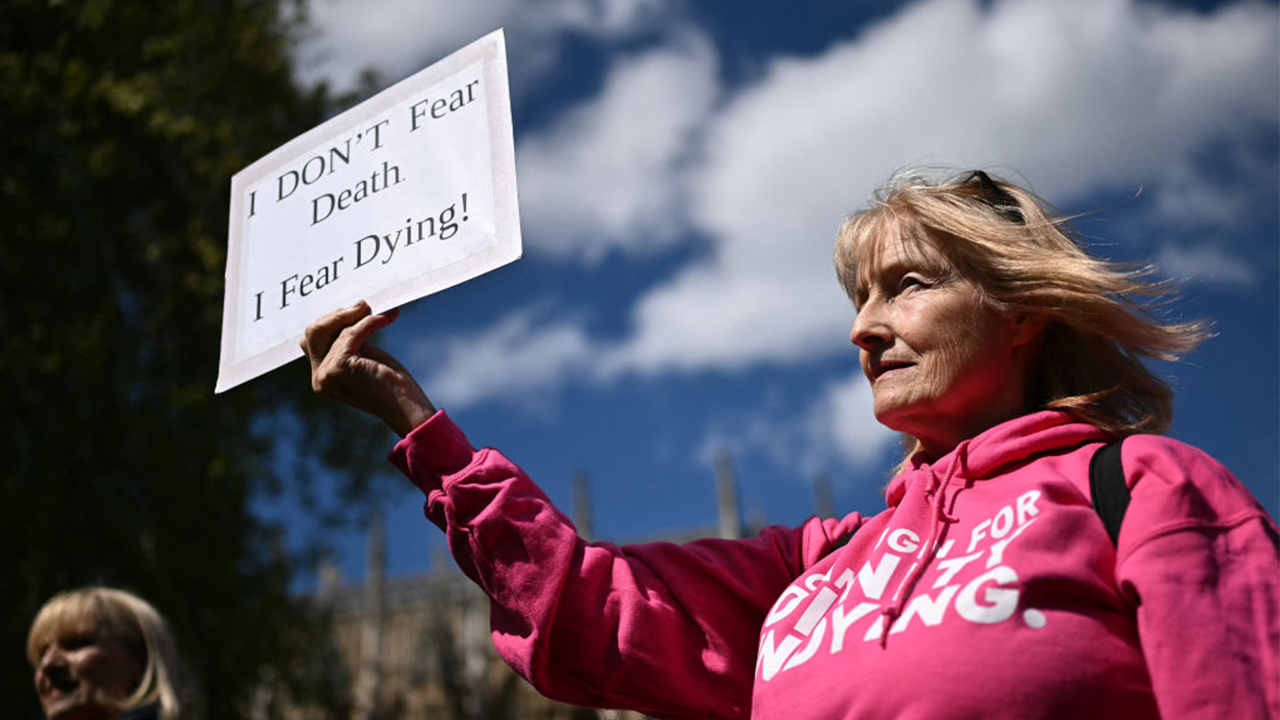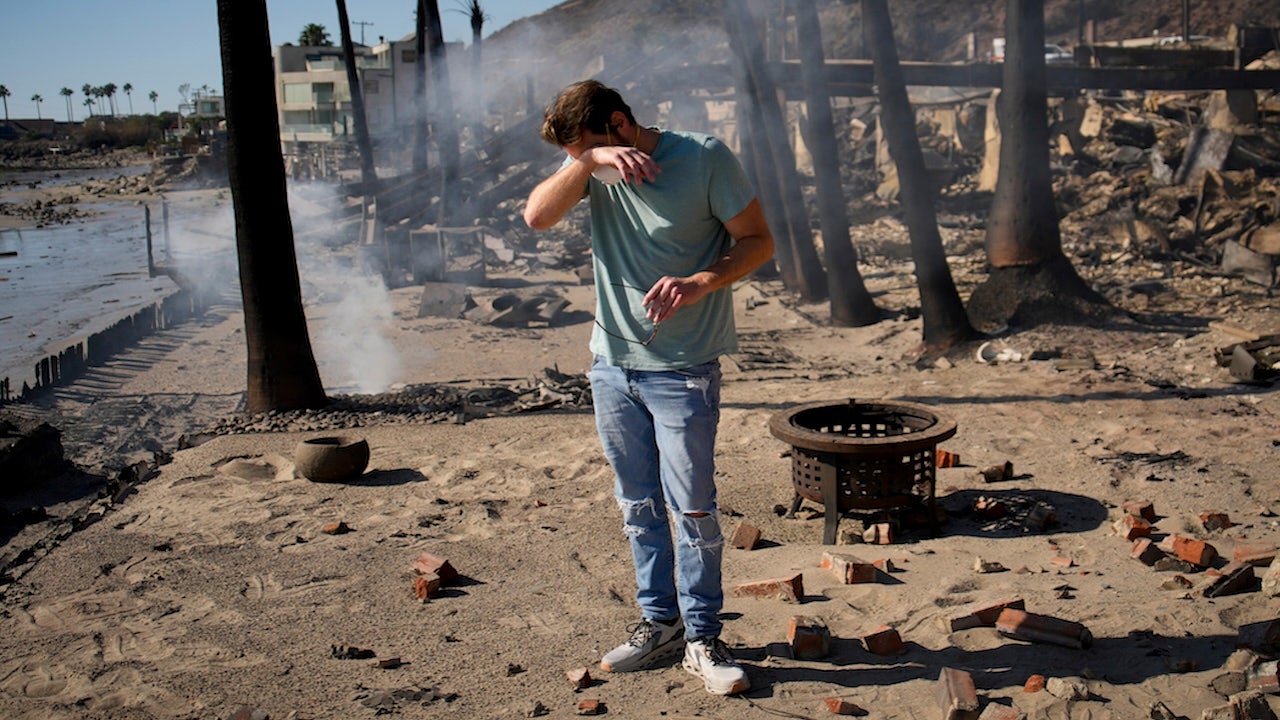Health
Terminally ill Missouri woman, 79, taking trip to Switzerland for assisted suicide

A terminally ill Missouri woman is planning to go to Switzerland to end her own life in a physician-assisted death while she is still physically capable of making the trip.
Gayle Hendrix, a 79-year-old mother of two from Cape Girardeau, was diagnosed with lupus and interstitial lung disease four years ago and says her lung capacity continues to worsen.
“I’ve had a great life, and I want to have some dignity when I’m going to the next phase,” she told 12 KFVS.
After her diagnosis, she says her shortness of breath continued to become worse and was breathing heavily even on flat surfaces.
PHYSICALLY HEALTHY DUTCH WOMAN DIES BY ASSISTED SUICIDE AT AGE 29
A doctor prepares a syringe with “Thiopental” a barbiturate that is used in the practice of euthanasia in a hospital in Belgium, on February 1, 2024. (Getty Images)

Health
How Kathy Bates Lost 100 Lbs—Plus Her Tips for Sustainable Weight Loss

Sign Up
Create a free account to access exclusive content, play games, solve puzzles, test your pop-culture knowledge and receive special offers.
Already have an account? Login
Use left and right arrow keys to navigate between menu items.
Use escape to exit the menu.
Health
California fires and mental health toll: Celebrities and therapists offer tips

As Los Angeles battles the worst wildfires in the city’s history, thousands of people have been displaced or have seen their homes burn to the ground.
Around 130,000 people were ordered to evacuate and some 10,000 structures were destroyed, according to the Associated Press. At least 10 people have died as a result of the blazes.
The devastation of the fires has undoubtedly taken a grave toll on the psyches of those affected, experts agree.
STEVE GUTTENBERG CALLS LA WILDFIRES ‘GREAT EQUALIZER,’ URGES PEOPLE TO LEAN ON ONE ANOTHER
Fox News Digital spoke with celebrities and mental health experts, who offered the following guidance for the people impacted.
Recognize your feelings
For those who have experienced a loss from the fires, common reactions include shock, disbelief and confusion, according to David Kessler, a grief counselor in Los Angeles and founder of Grief.com.
“I call it grief brain,” he told Fox News Digital.
Luke Dexter reacts as he sifts through the remains of his father’s fire-ravaged beachfront property in the aftermath of the Palisades Fire on Jan. 10, 2025 in Malibu, Calif. (AP Photo/John Locher) (AP Newsroom)
“Your mind is trying to comprehend what happened, and it’s a hard thing for it to do, because this is unimaginable that your house, your safety, is suddenly gone.”
Not all grief is related to death, Kessler noted, as there are many different types of losses.
“I always say grief is a change you didn’t want — and certainly a fire is a change we didn’t want,” he added.
WHAT IS PTSD? SYMPTOMS THAT CAN EMERGE AFTER EXPERIENCING A TRAUMATIC EVENT
It’s important to “self-validate” the reality of the loss, he said.
“People might give you toxic positivity of, ‘well, at least no one died,’” he said. “And while that’s true, the reality is you still have lost your home. Don’t let anyone minimize that.”
“The loss of a home is devastating and it can take years to recover.”
“I think we’re going to deal with a lot of depression after this, a lot of sadness.”
Actor Steve Guttenberg, who lives in Pacific Palisades, California, where fires erupted on Tuesday, shared how the disaster has impacted his own mental health.
“I’ve seen so much tragedy the last three or four days that I’ve got to be careful to … keep a hold of my mind,” he said in an interview with Fox News Digital.
“And I think that we’re going to deal with a lot of depression after this, a lot of sadness. And it’s going to be really tough because this is like nothing you’ve ever seen.”

Actor Steve Guttenberg, who lives in Pacific Palisades, California, where fires erupted on Tuesday, shared how the disaster has impacted his own mental health. (AGUSTIN PAULLIER/AFP via Getty Images; Fox News)
Gutenberg noted that while it’s “very normal” to be down, he is trying not to let himself “go down that hole.”
“But I’m pretty sad about this,” he added.
HOW TO COPE WITH ‘COLLECTIVE GRIEF’ WHEN MASS TRAGEDY STRIKES
Jonathan Alpert, a psychotherapist in Manhattan and Washington, D.C., noted that the grief following the Los Angeles fires is “profound.”
“It’s not just about the physical loss of homes or belongings — it’s also about the sense of safety and normalcy that has been lost,” he told Fox News Digital.
“It’s important for people to feel emotions and not ignore them. This is a normal reaction to such overwhelming loss and tragedy.”
Reach out for support
Guttenberg emphasized the importance of maintaining connections with others and drawing support from the community during a disaster of this magnitude.
“We’re social animals — we need people,” he said. “So I’m reaching out to my friends. There’s no way to meet right now because it’s so dangerous — so the best thing you cn do … is call and reach out and maybe you can drive somewhere.”

Experts agreed that it’s essential to avoid isolating yourself after a loss. “We need to be taken care of. We need other people around us.” (AP Newsroom)
Most of the people in town have evacuated, he pointed out. “There’s probably 10% of the population left here. Or less.”
Kessler reiterated that connection is critical after this type of trauma. “We need to be taken care of. We need other people around us. People equal safety,” he said.
“We need other people around us. People equal safety.”
Pastor Jesse Bradley of Grace Community Church outside Seattle, Washington, agreed that it’s essential to avoid isolating yourself after a loss.
“We need God and we need each other. Community is vital,” he told Fox News Digital.
“Family, friends and neighbors care about you. God sends His love through these people. Reject isolation. Don’t shut down and don’t shut people out.”
Take action
“In times of crisis such as this, regaining even small amounts of control can be grounding,” Alpert said.
He recommends creating a plan for what’s next, whether it’s finding temporary housing, accessing local resources or starting the process of rebuilding.
“Taking action — no matter how small — can help you move forward.”

Ben Treger hugs his wife Sarah Treger after finding his grandfather’s watches at the remains of their Pacific Palisades home on Thursday, Jan. 9, 2025. “If you do have survivor’s guilt, I always say the best thing is to take action,” one expert advised. (Juan Carlo/Imagn)
Kessler agreed, noting that people who are in the area but did not experience loss may feel a sense of relief mixed with guilt.
“If you do have survivor’s guilt, I always say the best thing is to take action,” he advised.
In the longer term, advocacy efforts can be a powerful tool in dealing with trauma, Alpert noted.
MIKE POSNER REVEALS HOW FAITH REDIRECTED HIS LIFE, OFFERS ADVICE ON SPENDING HOLIDAYS WITH FAMILY
“Working to improve fire prevention policies, supporting relief efforts or helping neighbors rebuild can provide a sense of purpose and empowerment during this difficult time,” he said.
Some people may be angry about the systems that failed to prevent the fires in the first place, Alpert acknowledged, and this anger can be a “powerful motivator.”
“Taking action — no matter how small — can help you move forward.”
“Use that energy to demand better, but don’t get stuck on the anger,” he advised.
“By holding leaders accountable for the policies — or lack thereof — that contributed to this devastation, and by asking the right questions and demanding answers, you might start to feel better.”
Seek professional help as needed
“The L.A. fires no doubt will not just leave physical scars, but deep emotional ones, too,” Alpert said.
“For many people, the fear, panic and helplessness experienced during the fires don’t just disappear — they linger, creating flashbacks, anxiety and difficulty functioning.”

“For many people, the fear, panic and helplessness experienced during the fires don’t just disappear — they linger, creating flashbacks, anxiety and difficulty functioning.” (iStock)
In many cases, this can lead to post-traumatic stress disorder (PTSD). Symptoms of this condition can include vivid memories of the fires, nightmares, hypervigilance or avoidance of anything that reminds someone of the event, Alpert said.
“It’s important to see this not as weakness, but rather, the mind’s and body’s way of trying to cope with extreme stress.”
“While the fires were devastating, they don’t diminish your strength or character.”
As you seek help, it’s also important to understand that PTSD doesn’t define you, he added.
“It’s a part of your experience, not your identity. While the fires were devastating, they didn’t diminish your strength or character.”
Lean on your faith
For those who have experienced traumatic grief, Kessler emphasized the importance of faith and spirituality.
CLICK HERE TO SIGN UP FOR OUR HEALTH NEWSLETTER
“They help ground us in a world full of fear,” he said. “And when we’ve lost everything, it can feel like our faith is the one thing we have to hold onto.”
During a time of crisis, Guttenberg said it’s important to “rely on anything that you believe in.”

Cesar Plaza becomes emotional while looking at his home destroyed by the Eaton Fire in Altadena, California, on Jan. 9, 2025. “It’s easy to be consumed with what you no longer have,” a pastor told Fox News Digital. (AP Photo/Nic Coury) (AP Newsroom)
“If you believe in your mom and dad, you rely on them, your brothers and sisters, your friends, your family. God, the universe.”
Above all, he added, “Just remember, you’re not alone. God is always with you. Jesus is always with you. You’ve got to hang on to that.”
Find ways to exercise gratitude
During times of hardship, it’s important to recognize the good things that are still in your life, Pastor Bradley said.
“It’s easy to be consumed with what you no longer have,” he told Fox News Digital.
For more Health articles, visit www.foxnews.com/health
“You need to be intentional to take inventory of the blessings in your life. For example, you might lose a home or business, but you still have family.”
This mindset will help you keep a healthy perspective and protect gratitude, Bradley added.
Health
Scientists May Be Able to Make Grapefruits Compatible With Medications They Currently Interfere With

You may be among the millions of people who have seen a surprisingly specific warning like this on the labels of drugs you take:
Avoid eating grapefruit or drinking grapefruit juice while using this medication.
Such warnings are issued for dozens of substances, including docetaxel, a cancer drug; erythromycin, an antibiotic; and some statins, the cholesterol-lowering drugs prescribed to more than a third of American adults over 40.
The problem is a set of molecules, furanocoumarins. High levels of furanocoumarins interfere with human liver enzymes, among other processes. In their presence, medications can build up to unhealthy levels in the body. And grapefruits and some related citrus fruits are full of them.
But there is no such warning for other kinds of citrus, such as mandarins and other oranges. Citrus researchers at the Volcani Center in Israel reported Wednesday in the journal The New Phytologist that, by crossing mandarins and grapefruit, they’ve uncovered genes that produce furanocoumarins in some citrus fruits. It’s a finding that opens the possibility of creating grapefruit that doesn’t require a warning label.
Scientists had worked out the compounds’ structures and pieced together a basic flowchart of how they are made years ago, said Yoram Eyal, a professor at the Volcani Center. But the precise identities of enzymes catalyzing the process — the proteins that snip off a branch here, or add a piece there — remained mysterious. He and his colleagues knew that one way to identify them was to breed citrus high in furanocoumarins with those without. If the offspring of such a cross had varying levels of the substances, it should be possible, by digging into their genetics, to pinpoint the genes for the proteins.
“We were afraid to approach it, because it’s very time-consuming and it takes many years,” he said, noting how involved it can be to grow new trees from seeds and assess their genetics. “But finally, we decided we have to dive in.”
When they examined the offspring of a mandarin and a grapefruit, the researchers saw something remarkable. Fifty percent of the young plants had high levels of furanocourmains, and 50 percent had none. That particular signature meant something very specific, in terms of how the ability to make these substances is inherited.
“We saw there was only one gene that could have controlled it,” said Livnat Goldenberg, a Volcani Center researcher who is the lead author of the new study.
The researchers soon identified the gene controlling the production of furanocoumarins in leaves and fruit, which produces an enzyme called 2-oxoglutarate-dependent dioxygenase, or 2OGD for short. Mandarins, it turns out, have a mutated form of this gene that keeps the enzyme from functioning properly. This version cropped up in all the mandarin and orange varieties the researchers checked, explaining why they do not cause the same problems as grapefruit in people taking prescription medications. In these plants, furanocoumarin production is paused.
With gene editing technology, it should be possible to alter the gene in grapefruit as well, Dr. Eyal suggests. The team at the Volcani Center is now exploring that project.
Looking at how widespread this mutated version is in mandarins and some other citrus, the scientists speculate that some gene nearby on the genome must play an important role in a highly prized trait. A long-ago citrus breeder, selecting for some unknown quality, must have unwittingly spread this furanocoumarin-busting version of the gene to an ancestor of modern varieties of mandarins and oranges.
All these years later, that person’s work is coming to light, under the gaze of geneticists, who may, someday, put grapefruit back on the menu.
-

 Politics1 week ago
Politics1 week agoNew Orleans attacker had 'remote detonator' for explosives in French Quarter, Biden says
-

 Politics1 week ago
Politics1 week agoCarter's judicial picks reshaped the federal bench across the country
-

 Politics7 days ago
Politics7 days agoWho Are the Recipients of the Presidential Medal of Freedom?
-

 Health6 days ago
Health6 days agoOzempic ‘microdosing’ is the new weight-loss trend: Should you try it?
-

 World1 week ago
World1 week agoSouth Korea extends Boeing 737-800 inspections as Jeju Air wreckage lifted
-
/cdn.vox-cdn.com/uploads/chorus_asset/file/25822586/STK169_ZUCKERBERG_MAGA_STKS491_CVIRGINIA_A.jpg)
/cdn.vox-cdn.com/uploads/chorus_asset/file/25822586/STK169_ZUCKERBERG_MAGA_STKS491_CVIRGINIA_A.jpg) Technology2 days ago
Technology2 days agoMeta is highlighting a splintering global approach to online speech
-

 World1 week ago
World1 week agoWeather warnings as freezing temperatures hit United Kingdom
-

 News1 week ago
News1 week agoSeeking to heal the country, Jimmy Carter pardoned men who evaded the Vietnam War draft

















